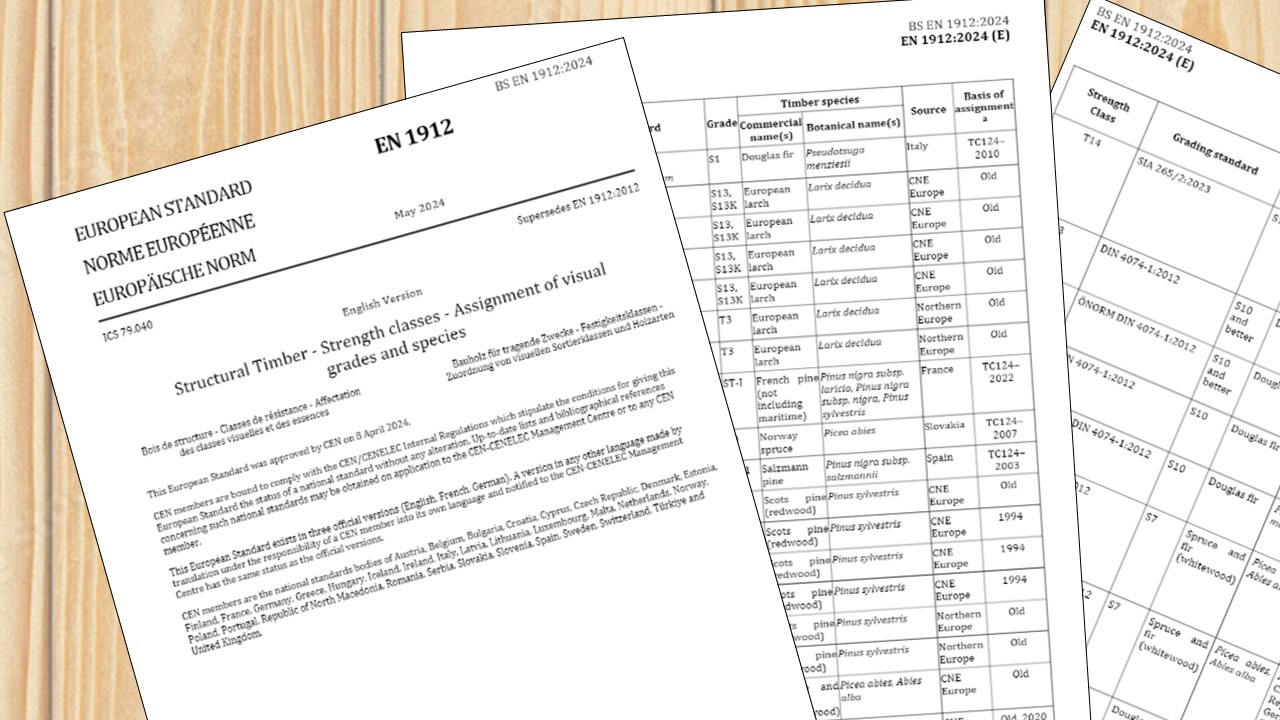
It has been a large amount of work to get the data in good order, but we finally have the updated version of EN 1912 – the standard that contains visual strength grading assignments. For key dates relating to publication, see the CEN website.
What do we mean by a visual grading assignment? Well, it is a short way of saying how you get to know the strength class (values to use in structural design calculations – the grade determining properties) based on the combination of:
- Visual strength grade, to a particular version of a visual grading rule
- For timber of a particular species or species group
- Grown in a particular geographical area
All three of these must match – because the grade determining properties, and the visual grading indicators, are highly influenced by species and growth conditions. For more about the basis of this see:
Ridley-Ellis, D., Stapel, P. & Baño, V. Strength grading of sawn timber in Europe: an explanation for engineers and researchers. Eur. J. Wood Prod. 74, 291–306 (2016). https://doi.org/10.1007/s00107-016-1034-1
EN 1912 does not list all the assignments for visual grades to strength classes. Assignments can also be listed in other standards or documents as long as they do not contradict EN 1912 and meet the requirements of EN 14081-1. For new assignments it is clearly the case that this requires a report to EN 384 examined by a Notified Body with appropriate competence. For grandfathered assignments deemed proven by practice over time without problems (akin to the basis “old” in EN 1912:2024) the situation is less clear cut – but this is a topic for another day.
For example, there are visual grading assignments for UK-grown oak and sweet chestnut to BS 5756 in PD6693-1. In recent times it has become expected by markets that an assignment is listed in EN 1912, but EN 1912 was originally only intended for the large volume international commercial markets. This explains why some old assignments were not included – especially for hardwoods.
EN 1912:2024 has a lot of new entries – almost double the previous version. It also has clearer definitions of growth areas and species, and some information about the basis of the assignments. It also now includes tension strength classes, thanks to their inclusion in EN 338.
You can read more in these previous posts about species and origin, and the reasons why an update was needed (November 2022 and November 2019).
Grading work does not stand still, and EN 1912:2024 does not include the latest update of poplar from Spain (Populus × canadensis cv ‘MC’, ‘Luisa Avanzo’), and pending the next update all approved additions can be found in a CEN TC124 WG2 TG1 document (Visual grading AGR) here.
Visual strength grading of timber is carried out according to grading rules that are usually (but do not have to be) national standards (like BS 4978 for softwoods and BS 5756 for temperate hardwoods). EN 1912:2024 contains quite a long list of grading standards, but they are not all totally unique:
- Irish Standard I.S. 127:2015 has similar rules to British Standard BS 4978.
- Netherlands Standard NEN 5499:2007 is a translated version of the Nordic INSTA 142.
- Netherlands Standard NEN 5493:2010+C1:2011 contains similar rules for tropical hardwoods to the European Standard EN 16737:2016. In fact EN 16737 was based on NEN 5493 and British Standard 5756. (BS 5756 was since updated to remove the tropical hardwood part).
- The German Standard DIN 4074-1:2012, for softwoods, is published as Austrian Standard ÖNORM DIN 4074-1:2012, Czech Standard ČSN 73 2824-1:2015 and Swiss Standard SIA 265/2:2023. Previous versions are the the basis for Slovenian Standard SIST DIN 4074-1:2009 and Slovak Standard STN 49 1531:2001.
- The German Standard DIN 4074-5:2008, for hardwoods, is also Austrian Standard ÖNORM DIN 4074-5:2009 and Slovenian Standard SIST DIN 4074-5:2009.
Visual grading rules get updated from time to time. The assignment in EN 1912 (or in the visual grading AGR) can be updated so long as the revised grading rule does not include any changes that might affect the grading assignment in an unsafe way (result in lower grade determining properties) – this is not the usual case, but since it might be the case, the references are not automatically updated. Information needs to be provided to CEN TC124 WG2.
You might be wondering how an assignment gets to be listed in EN 1912? Well, this is done by submitting a report of test data and calculations (see EN 384) to CEN TC124 WG2 TG1. This committee can also review historical reports done to previous standards.
